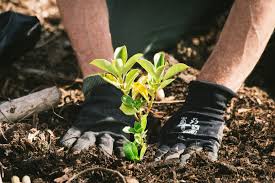10 Common Mistakes kiwi's Make When Planting Trees:
Date: 11 Jun 2024
Reap rewards from your investment of time and money by planting a tree correctly in New Zealand. Avoid these costly mistakes—all of which will impede, if not kill, a tree.
1 / 10
Root-bound Plants
Plants that have been grown in pots for too long become rootbound. This is particularly problematic with trees and shrubs because the roots circle around and fail to spread out and anchor the plant. Then as they grow taller, trees are prone to tipping over in a windstorm, especially after a heavy rain softens the ground. Avoid the problem by cutting the roots before planting. Cut into four equidistant sections of the root ball to free up the roots and encourage them to grow outward, then cut an X in the bottom of the rootball.
2 / 10
Balled-and-Burlapped Trees
Larger trees and shrubs are often sold in balled-and-burlapped form, also known as B&B. Natural burlap is biodegradable and will break down over time. But it is still important to remove the rope and metal basket surrounding the burlap. Make sure none of the burlap remains above ground because it can wick moisture from the roots. Treated burlap (look for green coloration) breaks down more slowly, so it should be removed if you can do so without breaking up the root ball. If that is a concern, push the treated burlap away from the sides of the root ball when planting. Plastic burlap should be removed altogether because it won’t break down at all.
3 / 10
Poorly Drained Soil
While some species of trees can tolerate poorly drained soil, most trees cannot. Observe the planting site after rain. If there are puddles, that is not a good sign. You can also dig a test hole, fill it to the top with water, and let it drain. If it takes 15 minutes or more to drain, move on to another site.
4 / 10
Planting Trees Too Closely
Avoid planting trees too closely together. They’ll grow spindly, crowd each other, and all suffer as a result. Plant an odd number of trees, such as 3 or 5, in a small makeshift grove, but give them 5 to 10 feet of space so they have a chance to gain some size.
5 / 10
Grassy Competition
Grass can impede the growth of trees. Some uncut orchard grasses actually release an aleopathic chemical that slows or even halts the growth of woody plants. Remove the grass and keep the base of the tree free of competing plants out to the dripline (the outer extent of the canopy). Trees will grow faster and be healthier with a mulch of wood chips or, even better, compost.
6 / 10
Too Much Mulch
Don’t put mulch on too heavily because you’ll smother roots. About 2 or 3 inches is all that’s needed. Keep it away from the trunk of the tree. Piling mulch against the trunk creates a volcano effect, trapping moisture against the bark and leading to rot and insect infestation. Keep mulch a good 3 to 5 inches away from the base of the tree.
7 / 10
Planting Too Shallow
Plant trees at the same height they grew in the nursery. Remove them from their pots, brush off any loose mulch, and look for where the base of the trunk starts to taper. That taper should be just above soil level after planting. Trees planted too shallow will usually survive, but they will be slowed down. When erosion occurs, valuable feeder roots are destroyed, further diminishing the tree’s performance.
8 / 10
Planting Too Deep
Planting too deeply can kill a tree. The stem on a young tree should not be perfectly cylindrical from top to bottom. There should be a taper at the base where the tree transitions from trunk to roots. If this tapered base is buried, the tree will suffer and eventually die. Make sure the taper is visible after planting.
9 / 10
Amending Soil
Amending soil with compost, peat moss, and other additives was once accepted advice, but if surrounding soil is poor, tree roots end up staying in their “comfort zone.” They don’t have the incentive to spread out and anchor the plant. Also, a heavily amended planting hole collects excess water when surrounded by heavy, nonporous clay. If you are going to amend the soil, amend a much larger area—at least 1.5 to 2 metres.
10 / 10
Not Enough Water
Insufficient watering is probably the number one reason newly planted trees don’t survive. Water deeply after planting and weekly after that for the first year or two. Leave a basin around the tree to funnel water to the roots. A newly planted tree needs at least 20 litres of water per week. A simple way to ensure this is to drill a couple of small holes at the base of a plastic 20-litre bucket. Fill the bucket with water weekly and let it slowly drain into the basin surrounding the tree.
Plant your trees correctly to ensure they thrive and add beauty to your New Zealand garden for years to come.
Link: Contact your local Lawn Rite today
Back...
